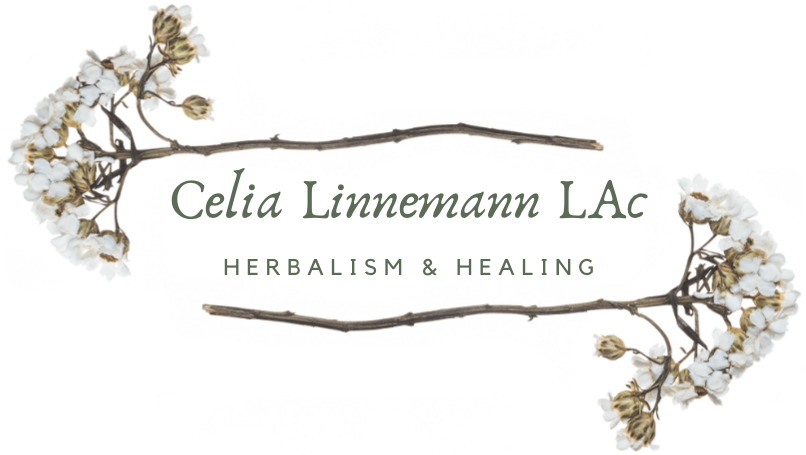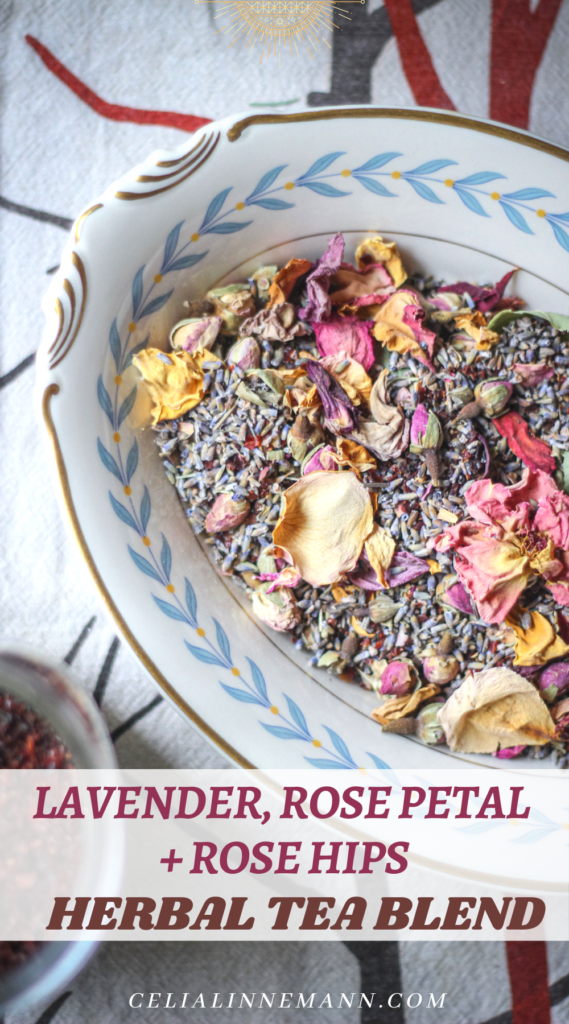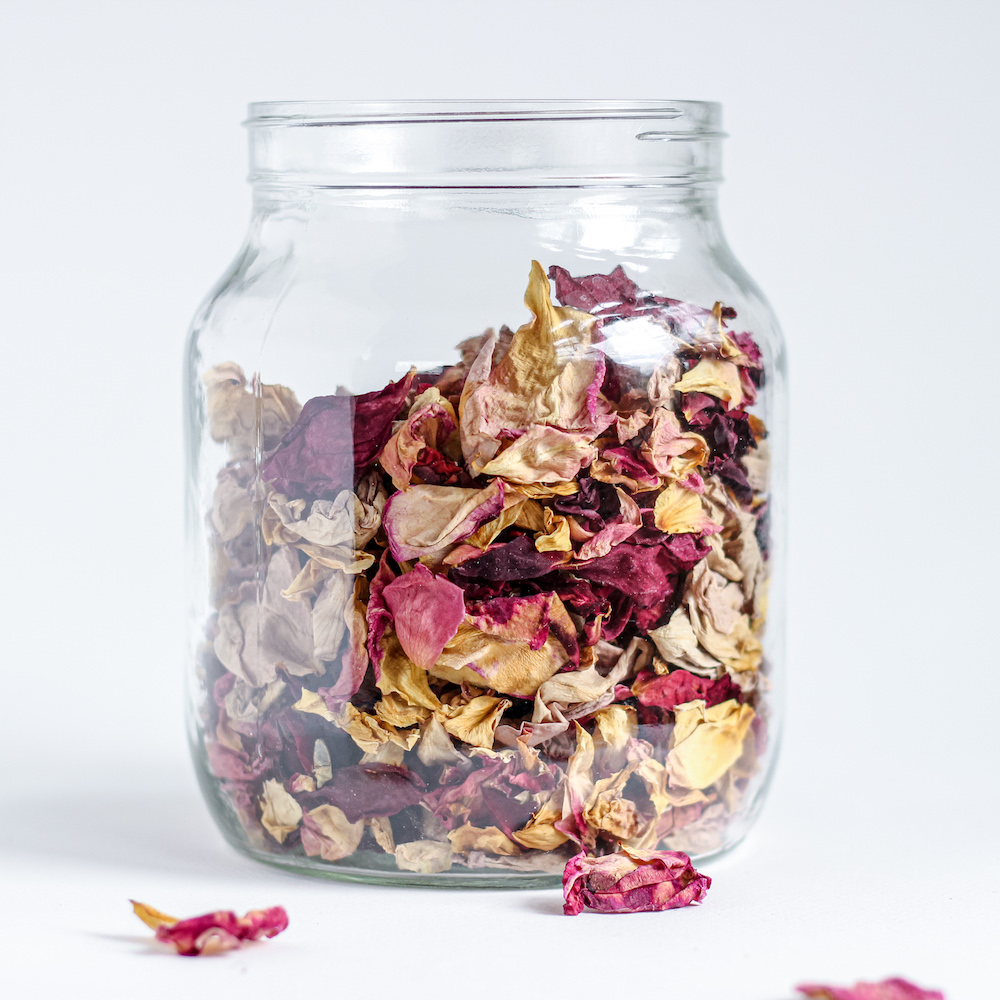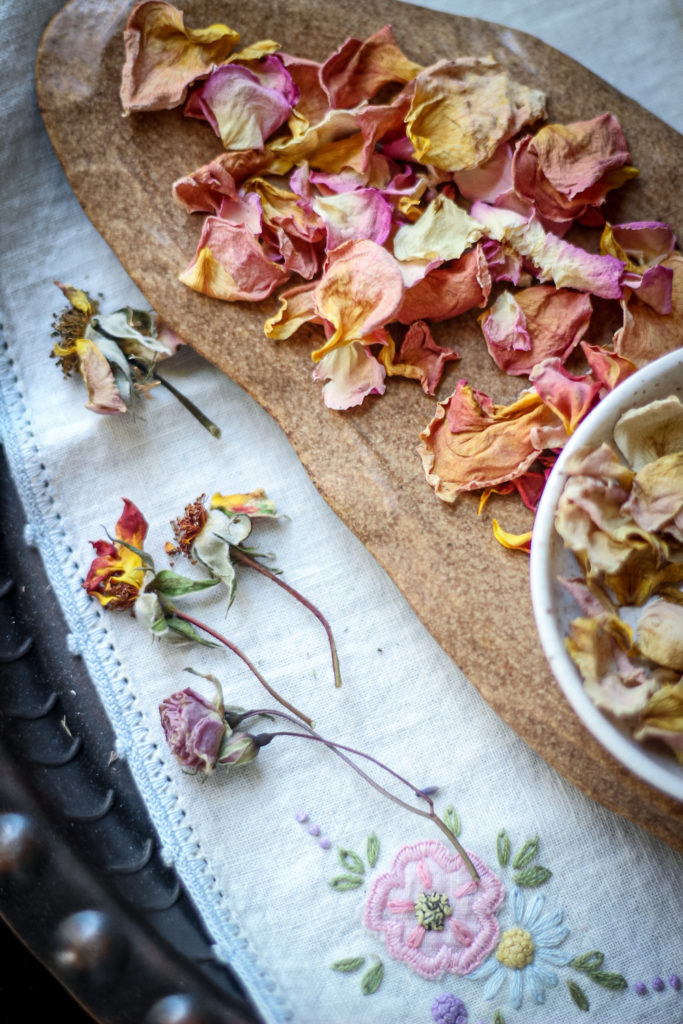Lessons in herbal tea blending: How to combine competing flavors?
I love herbal tea blending. Whether it’s an floral herbal sipping tea like the Lavender and Rose tea blend in this post, or a potent medicinal blend, creating a batch of tea for someone is a fun way to work with and share herbalism.
In this post I am going to weave in some lessons on herbal tea blending. This is not a clear “workshop” or “lesson plan” per se, but things for your consideration while engaging with the art of herbal tea blending and formulation.
Topics for your herbal tea blending (or formulating) consideration:
- When do you formulate? Is every tea a formula/blend, and why?
- What is the difference, if any, between herbal tea blending and formulation?
- How can you blend two herbs with competing flavors?
- What is harmonization of herbal tea blends (and which herbs do you use for this and why?)
A little tea blending story
A while ago I had a request from a client for a Rose and Lavender herbal blend. Seems simple enough, right?
But when I tasted just the two herbs together, I felt like it needed a little more depth and a variance of flavor. The aroma and distinctive flavors of the two flowers competed and overpowered each other.
The client was clear that they did not want other flavors. No Licorice, no Ginger, no Cinnamon, no Citrus Peel. So I began by playing around with proportions. I tried more Lavender than Rose – tasted like soap. More Rose than Lavender was much better.
How could I bring these two separate herbs together in a cohesive blend?
And more importantly, how can this tea taste the best it can?

What is the difference between making teas and herbal tea blending or formulation?
I recently came across a tea blend that combined Chamomile and Vitex (and other herbs) for PMS, and I tried to imagine how it would taste and how it would land energetically in the body.
It is totally okay to use whatever herbs you want for whatever purpose. That’s the great thing about working with herbs – we have freedom to engage with the medicine however we please.
The more I thought about it, I realized that tea formulation or blending is intentional, whether we are creating for medicine, or for flavor, and anything in between.
For the purposes of this article, formulation is how and why we choose certain herbs for a specific purpose.
What, then is tea blending and how is it different from herbal tea formulation? This is when I wish we could all sit down with a cup of tea and talk about this in person, because these sorts of topics make for inspiring discussion.
For this article, though, I think formulation and blending are mostly interchangeable. In other situations this might not be the case.
Formulation is a sticky topic because it is as personal as the entire reason we engage with herbs in the first place. Formulation brings in questions about what we are doing and why. To get really broad, I think formulation is a representation of our entire worldview and human experience.
Are you familiar with Ted Kaptchuck’s The Web That Has No Weaver? This book is about Chinese medicine theory for Westerners. In the beginning, he illustrates how our cosmologies and view of religion directly influences our beliefs about disease, the body and how to treat it.
In general, the West believes in monotheism and this idea has spilled over to medicine. There’s one God, and there’s One True Reason for an illness and One True Reason for a treatment. Another example is that we generally believe there is one pathogen that causes a specific infection, and one singular medicine to treat it.
This spills over into herbalism, too, of course.
Back to that Chamomile and Vitex formula for menstrual cramps. My interpretation for how these herbs were chosen may be because it is believed that hormones influence menstruation and Vitex is “good for balancing hormones” so it is used here, and Chamomile is very calming, like a sedative, so it is used to help deal with pain.
This is not a critique of a formula but an illustration as to how I see formulation taking place.
In formulation, consider your view of health, wellness, illness (or whatever context from which you are formulating).
What is a pathogen to you?
What is the root of illness or dis-ease?
What does feeling good feel like to you?
What exactly do you want to feel and how are you going to get there?
Funny that I would talk about formulation in a simple request for a two herb sipping tea.
But I felt like the experience of a sensuous floral tea blend needed a little more intentional formulation or blending to get it to deliver its medicine, or meet the client’s goal of a tasty tea. (It needed harmonizing, which I’ll talk about below).
When are we formulating?
Here’s another thing I’ve been thinking about:
Is formulation something we do sometimes, but don’t do other times? Or is every tea blend a formulation, even if we are not trying to formulate?
And: are simples (a tea with just one herb) formulations, too?
Right now I am leaning towards thinking every tea blend we make is a formulation, and sometimes that formulation is more pronounced and intentional.

How to harmonize a tea blend?
Formulation considered and works with the interactions between herbs, and how herbs work in the body.
This Lavender and Rose tea blend request came during a time when I was elbows-deep into East Asian herbal medicine. Chinese herbal formulas are built with a purpose. They have a structure and clear framework as to why each herbs is present.
And the herbal formulas are often harmonized: herbs are added (or have a double duty) to help everything blend well and support the capability to be received and utilized by the body through functional digestive processes.
Common Harmonizing herbs in Chinese Medicine
- Gan Cao and Zhi Gan Cao / Licorice and prepared or Honey-Fried Licorice
- Da Zao / Jujube Date
- Sheng Jiang and Gan Jiang / Fresh and dried Ginger
- Chen Pi / Citrus Peel
As you can see, these are herbs that support digestive processes. Jujube Date is outside Western herbalism, but it is an earthy, sweet dried fruit which helps to warm and tonify Spleen Qi. Da Zao/Jujube Date is different from the other herbs on this list because they are not aromatic. It is used so frequently because it helps digestive function.
(Digestion is of utmost importance in East Asian medicine, because digestion, along with the air we breathe, is the source of Post-natal Qi, the vitality we have to live on every day of our lives. If you want to learn more, I wrote about the Spleen and Stomach in Chinese medicine, and foods to nurture the Earth element).
I was getting the feeling that if I were to harmonize this Lavender and Rose tea blend, it would be through a not spicy, non aromatic direction like Da Zao.
A variety of Roses – and Rose parts
I had three different varieties of Roses to work with: Rosebuds, commercial Rose Petals (those smallish pinking-red ones), and a mishmash of local Rose Petals.
After testing them all, I much preferred the locally harvested Rose petals. The flavor was broader and more harmonious for blending. To add visual and flavor variety (and to stretch my small stash of local roses), I used the small pink Rosebuds, too.
I could’ve just used the Rosebuds, but the Oregon Rose petals impart such a different quality of Rose flavor that I had to include them. Hand-harvest Rose petals have a spicy, dryer, milder flavor than the standard Rosebuds, although this varies widely from species to species. When working with domesticated garden roses, only use those which are highly scented and guaranteed not to be sprayed. My personal favorite domesticated Rose is David Austin “Jude the Obscure”.
What garden roses lack in wildness they make up for in freshness – at least for me because I live in an urban area. Garden Rose petals blend extremely well with other herbs while the rosebuds tend to dominate. In fact, I see Rose petals as a type of formula harmonizer in and of themselves which you can read about in this post about a Cedar, Rosemary and Rose tea.
The Rose petals blend so nicely herbs that the rose taste is barely noticeable, if at all. Those foraged petals are quite a different animal than the concentrated buds. The local Rose petals are varied, coming from different plants at different times. To me, this adds to their appeal all the more. Yellow, peach, white, mauve, fuschia, pink, red, pale lavender and any shade in between. Oh, and then there’s the delicately curled pinnate rose leaves. The rose petals impart a wildness, albeit an urban, one to any cup of tea.
There is a tea I adore called Day 1 tea for menstruation and for affirming the Heart- Womb connection. It has Rose petals, Bai Shao (White Peony root), Yarrow, Raspberry and warming spices. And once again, the Rose petals help to harmonize it all.
Roses are common for me to use in formulas. Here are two other formulas which I feel would not be the same if Rose was not in them:
St. John’s Wort and Chamomile tea blend for the brain-gut connection
Lead with the Heart – Hawthorn, Motherwort and Rose Tea Scroll waaaaaay down to see the formula.

Rose Hips: a weighter Earthier herb to center a formula
I sat with this tea for a while, because I still felt it needed something to give it some grounding. Since those flavorful spices were out, I wondered about Rose Hips since they are from the Rose plant, too. They would be like adding Da Zao / Jujube Date as a harmonizer.
I checked in with the client and they said they were open to Rose Hips. I was glad to use them, because the heavier, denser Rose Hips would added a deeper dimension and texture to the tea.
The Rose Hips contain hints of sweet and tart, and give the brewed tea a smoky rose color. They weighed down the high floral and fragrant blossoms. This assisted in allowing the taste of the tea to linger on the palate, rather than up and float away.
This was not a medicinal blend per se, although Rose, Lavender are, of course, quite medicinal. But yet it still illustrates the idea of considering lessons of herbal tea blending (or is it formulation?!).
Both of these herbs are gentle but effective nervines with a sense of emotional soothing. Lavender is quite calming, almost to a sedative level, Rose is a quintessential heart centerer, soother and passion holder, and Rose Hips offer nourishment and quenching/protection as a high flavonoid, Vitamin C rich herb.
Triple Rose and Lavender Herbal Tea Blend
- 1 part Lavender flowers
- 1 part Rosebuds
- 2 parts Rose Hips
- 1/2 part hand-harvested Rose Petals

Herbalism as time and space medicine
Is it farfetched to think clouds and wind and the buzz of pollinating bees can be captured in herbs that were harvested that day?
And when we sip a tea, does that snapshot of time resonate within our bodied and spirit?
Happy Rose tea blending to you all,
Celia












Hi I’d love to know if I can buy the rose bud and lavender tea from you and what tea would you recommend for me for Anxiety please. Thank you. Sharon